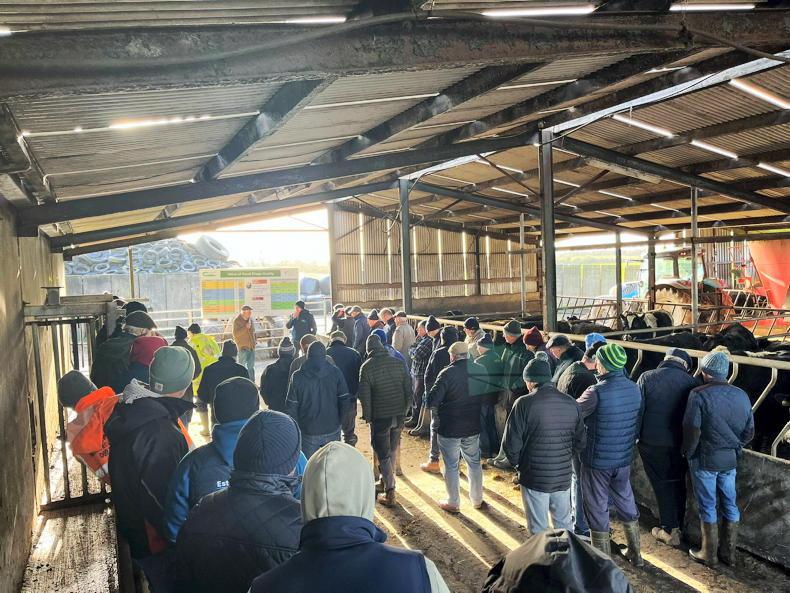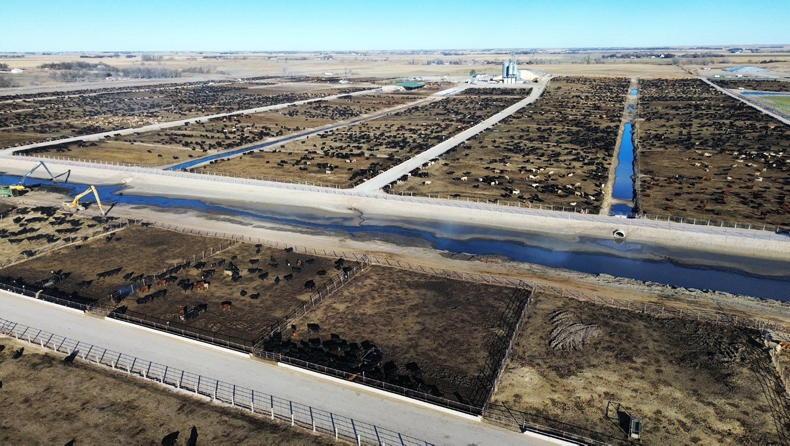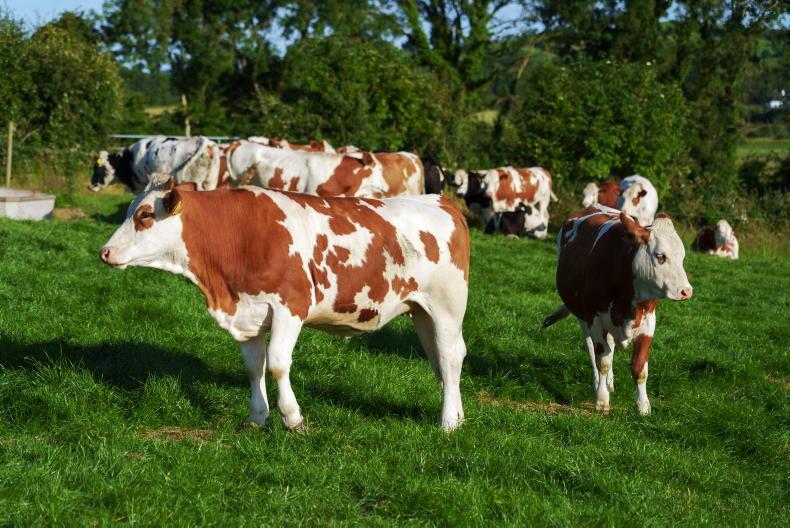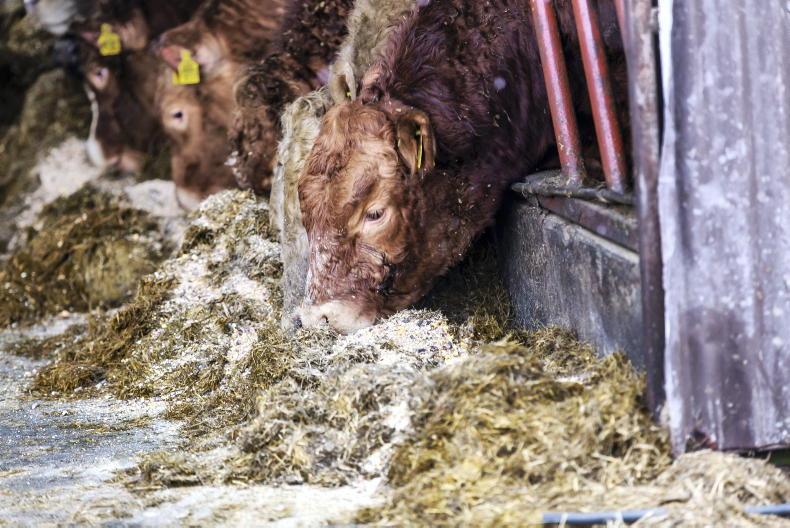Last week the importance of a mid-winter weighing was detailed here.
This allows you to assess how stock have performed since housing in autumn. You can assess the success of your winter diet and it also allows for any period of underperformance to be detected at the earliest possible stage.
Let’s assume you have weighed stock and based on the target weights outlined in the last article, you have found that stock are behind target. Depending on the number of animals that are behind target and the degree of the shortfall, the plan of attack will be different.
Of the 40 Angus and Hereford heifers on farm, 10 are more than 20kg behind target while the rest are close or above to the target weight.
Action: separate out the lightest 10 heifers and pen them together. Give them priority to the best silage available on the farm. It is likely that these are shy feeders and so have not been getting their fair share of concentrate supplementation.
Therefore giving them more space and taking the stronger animals away from them should allow them to eat the correct allowance each day.
In this case, I wouldn’t increase meal feeding to these cattle as they will likely compensate once they get a bit of preferential treatment and more space.
These 10 heifers should be targeted to be the first stock turned out to grass once conditions allow.
All 2022-born stock are 20kg or more behind target weight and the aim is to slaughter at 24 months old.
Action: there are at least two potential causes for this. Either the diet being delivered is not adequate to meet the daily liveweight growth target or there is an underlying health issue that is compromising the overall performance of stock within the shed.
It is worth taking a dung sample to be tested by your vet or local lab for worms. There could also be a fluke issue which may or may not be detected in a dung sample so discuss the best approach with your vet, especially on farms where fluke has been an issue in the past.
If the health side of things is not the issue then you need to look at the diet being delivered. Has the silage been tested and tested correctly? It is always worth testing silage a couple of times throughout the winter period to ensure the quality being delivered is as expected.
If silage quality is poorer than expected, increase meal feeding. At a target growth rate of 0.65kg/day for those operating a 24-month production system, 2kg of concentrate alongside a 65%DMD silage should be sufficient. If silage is as low as 60%DMD meal feeding will need to increase to 2.75kg/day.
All 2022-born stock are 35kg behind target and the aim was to slaughter off grass at the end of the upcoming grazing season.
Action: For those trying to finish stock at between 19 and 22 months of age off grass this autumn, the target growth rate over winter should be higher than those that plan to finish at 24 months old.
A daily liveweight gain of between 0.7kg/day and 0.8kg/day should be the target for the first winter in this system.
If stock are already 35kg behind target I would suggest looking at pushing out slaughter age to 24 months at least as trying to bring stock back on target will take a lot of meal feeding and will likely never be fully achieved within the expected time frame leading to lighter carcase weights and higher feed costs resulting in lower margins.
If there are some that are closer to the target that could be fed on and finished at the end of the grazing season this would help to reduce the housing pressure next winter and aid with cashflow.
The other option would be to offload some or all stock in the mart as stores at the end of the grazing season.
In this case you need to look at why stock are so far behind target – is it genetics, feeding or health?
From here, try to come up with a plan to improve the system this year so that in January 2024 you are not faced with the same dilemma.
Read more
Thrive: what weight should dairy beef yearlings be today?
Thrive weekly roundup: stock target weights and milk replacer costs
Last week the importance of a mid-winter weighing was detailed here.
This allows you to assess how stock have performed since housing in autumn. You can assess the success of your winter diet and it also allows for any period of underperformance to be detected at the earliest possible stage.
Let’s assume you have weighed stock and based on the target weights outlined in the last article, you have found that stock are behind target. Depending on the number of animals that are behind target and the degree of the shortfall, the plan of attack will be different.
Of the 40 Angus and Hereford heifers on farm, 10 are more than 20kg behind target while the rest are close or above to the target weight.
Action: separate out the lightest 10 heifers and pen them together. Give them priority to the best silage available on the farm. It is likely that these are shy feeders and so have not been getting their fair share of concentrate supplementation.
Therefore giving them more space and taking the stronger animals away from them should allow them to eat the correct allowance each day.
In this case, I wouldn’t increase meal feeding to these cattle as they will likely compensate once they get a bit of preferential treatment and more space.
These 10 heifers should be targeted to be the first stock turned out to grass once conditions allow.
All 2022-born stock are 20kg or more behind target weight and the aim is to slaughter at 24 months old.
Action: there are at least two potential causes for this. Either the diet being delivered is not adequate to meet the daily liveweight growth target or there is an underlying health issue that is compromising the overall performance of stock within the shed.
It is worth taking a dung sample to be tested by your vet or local lab for worms. There could also be a fluke issue which may or may not be detected in a dung sample so discuss the best approach with your vet, especially on farms where fluke has been an issue in the past.
If the health side of things is not the issue then you need to look at the diet being delivered. Has the silage been tested and tested correctly? It is always worth testing silage a couple of times throughout the winter period to ensure the quality being delivered is as expected.
If silage quality is poorer than expected, increase meal feeding. At a target growth rate of 0.65kg/day for those operating a 24-month production system, 2kg of concentrate alongside a 65%DMD silage should be sufficient. If silage is as low as 60%DMD meal feeding will need to increase to 2.75kg/day.
All 2022-born stock are 35kg behind target and the aim was to slaughter off grass at the end of the upcoming grazing season.
Action: For those trying to finish stock at between 19 and 22 months of age off grass this autumn, the target growth rate over winter should be higher than those that plan to finish at 24 months old.
A daily liveweight gain of between 0.7kg/day and 0.8kg/day should be the target for the first winter in this system.
If stock are already 35kg behind target I would suggest looking at pushing out slaughter age to 24 months at least as trying to bring stock back on target will take a lot of meal feeding and will likely never be fully achieved within the expected time frame leading to lighter carcase weights and higher feed costs resulting in lower margins.
If there are some that are closer to the target that could be fed on and finished at the end of the grazing season this would help to reduce the housing pressure next winter and aid with cashflow.
The other option would be to offload some or all stock in the mart as stores at the end of the grazing season.
In this case you need to look at why stock are so far behind target – is it genetics, feeding or health?
From here, try to come up with a plan to improve the system this year so that in January 2024 you are not faced with the same dilemma.
Read more
Thrive: what weight should dairy beef yearlings be today?
Thrive weekly roundup: stock target weights and milk replacer costs










SHARING OPTIONS